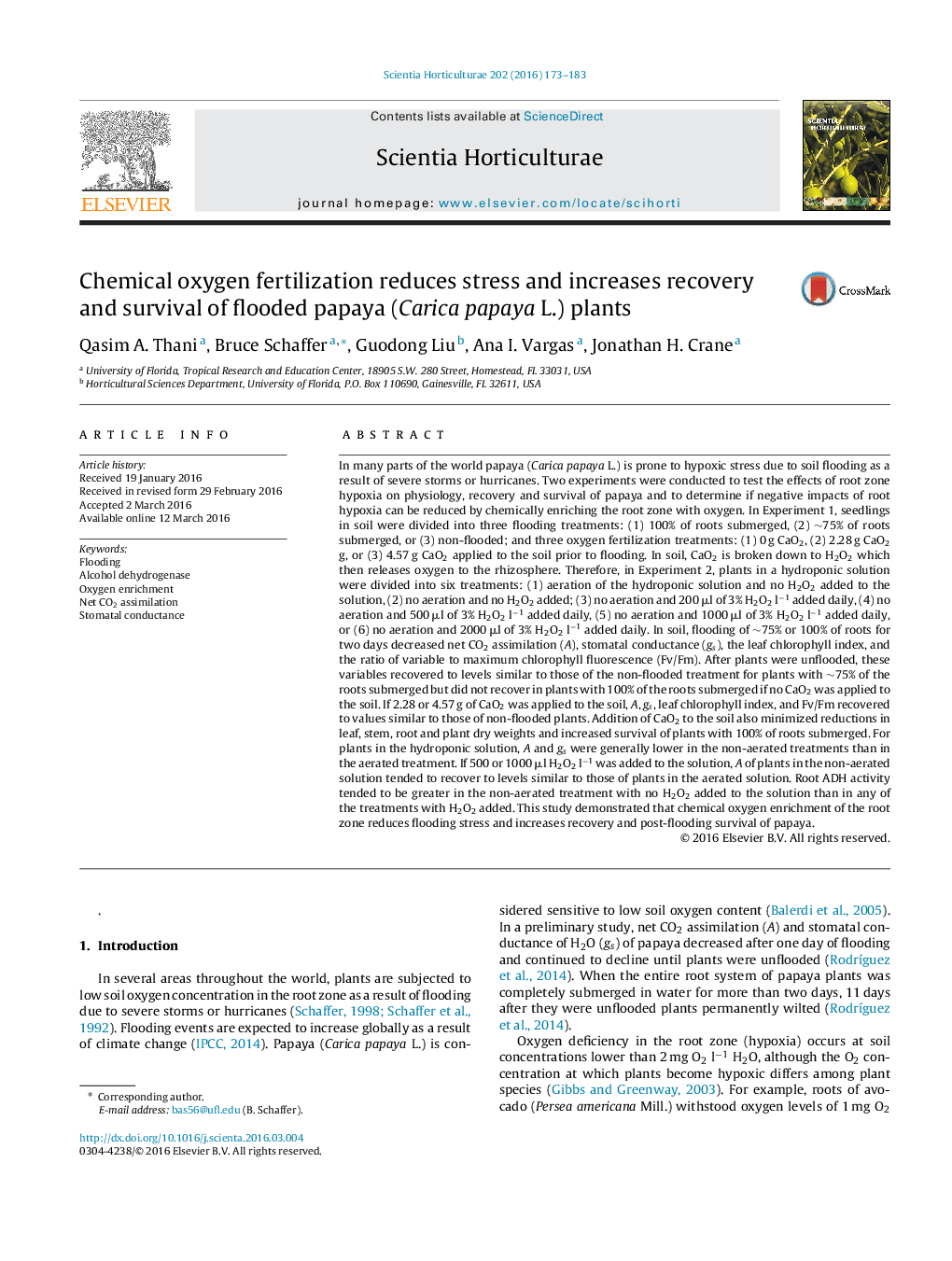| کد مقاله | کد نشریه | سال انتشار | مقاله انگلیسی | نسخه تمام متن |
|---|---|---|---|---|
| 4566013 | 1628796 | 2016 | 11 صفحه PDF | دانلود رایگان |

• Flooding papaya seedlings for 2–3 days reduced leaf gas exchange and plant growth.
• Adding H2O2 to a hydroponic solution reduced plant stress caused by low oxygen.
• Soil-applied CaO2 improved recovery and survival of papaya from flooding.
In many parts of the world papaya (Carica papaya L.) is prone to hypoxic stress due to soil flooding as a result of severe storms or hurricanes. Two experiments were conducted to test the effects of root zone hypoxia on physiology, recovery and survival of papaya and to determine if negative impacts of root hypoxia can be reduced by chemically enriching the root zone with oxygen. In Experiment 1, seedlings in soil were divided into three flooding treatments: (1) 100% of roots submerged, (2) ∼75% of roots submerged, or (3) non-flooded; and three oxygen fertilization treatments: (1) 0 g CaO2, (2) 2.28 g CaO2 g, or (3) 4.57 g CaO2 applied to the soil prior to flooding. In soil, CaO2 is broken down to H2O2 which then releases oxygen to the rhizosphere. Therefore, in Experiment 2, plants in a hydroponic solution were divided into six treatments: (1) aeration of the hydroponic solution and no H2O2 added to the solution, (2) no aeration and no H2O2 added; (3) no aeration and 200 μl of 3% H2O2 l−1 added daily, (4) no aeration and 500 μl of 3% H2O2 l−1 added daily, (5) no aeration and 1000 μl of 3% H2O2 l−1 added daily, or (6) no aeration and 2000 μl of 3% H2O2 l−1 added daily. In soil, flooding of ∼75% or 100% of roots for two days decreased net CO2 assimilation (A), stomatal conductance (gs), the leaf chlorophyll index, and the ratio of variable to maximum chlorophyll fluorescence (Fv/Fm). After plants were unflooded, these variables recovered to levels similar to those of the non-flooded treatment for plants with ∼75% of the roots submerged but did not recover in plants with 100% of the roots submerged if no CaO2 was applied to the soil. If 2.28 or 4.57 g of CaO2 was applied to the soil, A, gs, leaf chlorophyll index, and Fv/Fm recovered to values similar to those of non-flooded plants. Addition of CaO2 to the soil also minimized reductions in leaf, stem, root and plant dry weights and increased survival of plants with 100% of roots submerged. For plants in the hydroponic solution, A and gs were generally lower in the non-aerated treatments than in the aerated treatment. If 500 or 1000 μl H2O2 l−1 was added to the solution, A of plants in the non-aerated solution tended to recover to levels similar to those of plants in the aerated solution. Root ADH activity tended to be greater in the non-aerated treatment with no H2O2 added to the solution than in any of the treatments with H2O2 added. This study demonstrated that chemical oxygen enrichment of the root zone reduces flooding stress and increases recovery and post-flooding survival of papaya.
Journal: Scientia Horticulturae - Volume 202, 20 April 2016, Pages 173–183